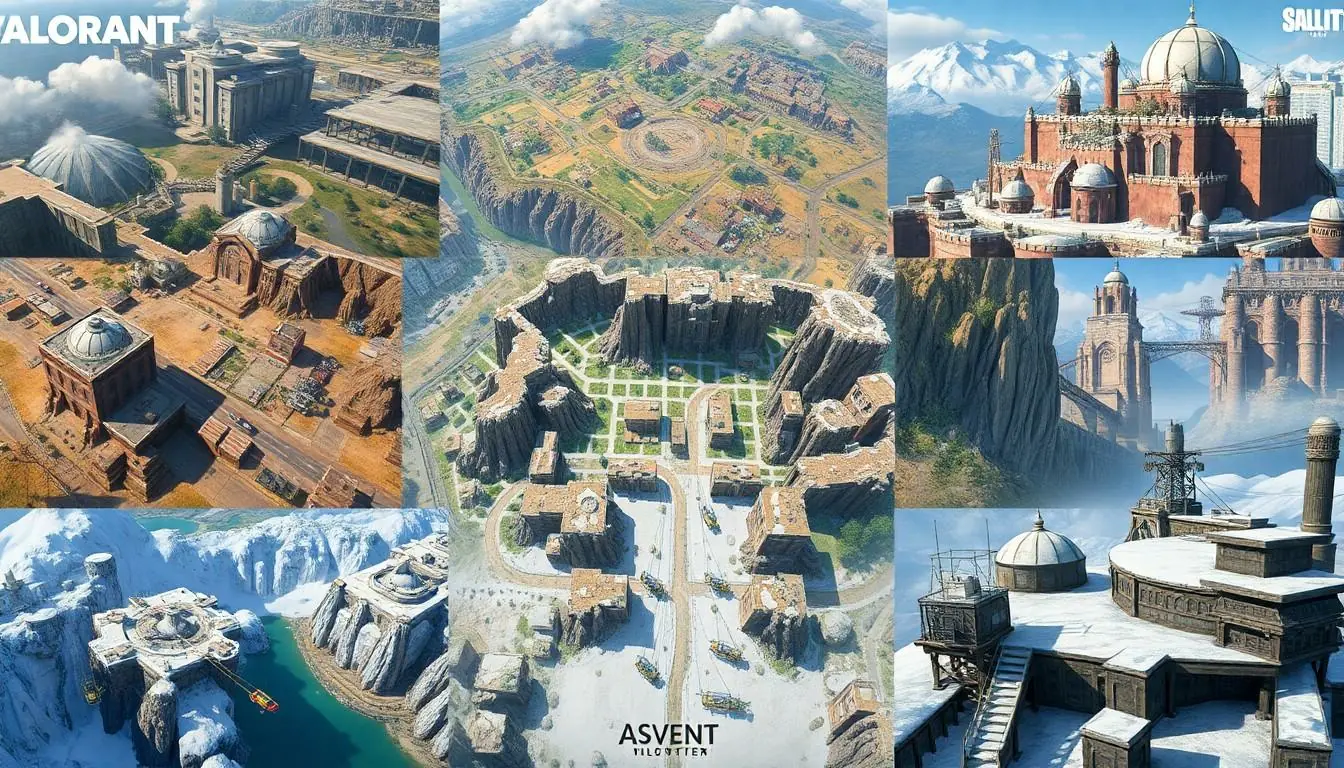Table of Contents
ToggleIn the world of Valorant, every map tells a story, and those names? They’re like the quirky characters in a sitcom. From the sun-soaked streets of Breeze to the eerie corners of Ascent, each location offers a unique vibe that can make or break a match. Ever wondered why they chose such peculiar names? Spoiler alert: it’s not just for the fun of it.
Overview Of Valorant Map Names
Valorant features various maps, each with distinctive names that reflect their unique design and theme. Breeze, for instance, offers an open environment with tropical elements, creating a spacious feel that encourages long-range encounters. Ascent presents a mix of urban and natural landscapes, emphasizing verticality and strategic positioning.
Icebox stands out with its industrial aesthetic, featuring snowy terrain and a focus on vertical gameplay. Split emphasizes tight corridors and multi-level spaces, fostering close-quarter engagements. Each map’s name and design work together to set specific atmospheres, impacting player strategies and teamwork.
Haven differentiates itself by having three bomb sites rather than the traditional two, leading to diverse tactical options. Bind, with its unique teleporters, challenges players to adapt their strategies dynamically. The design choices behind these maps add depth to the game, enhancing both casual play and competitive matches.
Fracture introduces an innovative layout, allowing for quick rotations and various engagement choices. The map’s names not only offer insight into their features but also evoke a sense of place, enriching the overall gaming experience. Players often connect emotionally with these maps and their themes, strengthening the immersive nature of Valorant.
These names contribute significant meaning to the gameplay, allowing players to understand each map’s purpose and style. Understanding the intricacies of Valorant’s maps leads to improved strategies, benefiting all players involved.
Breakdown Of Each Map
Each Valorant map features distinct characteristics that shape gameplay experiences. Below is a closer look at the maps.
Bind
Bind’s unique design includes teleporters that connect various locations, providing strategic advantages in gameplay. Players frequently employ these teleporters to surprise opponents and rotate quickly. The layout promotes diverse engagement strategies, making every round unpredictable. Open areas surrounding bomb sites encourage teamwork and communication, enhancing the overall player experience. Balancing the tight corridors with wide spaces creates opportunities for both defensive and aggressive play styles.
Haven
Haven stands out with three bomb sites, allowing for varied strategies and tactics. This unique feature encourages teams to divide resources, creating pressure on opponents. The rich aesthetics blend urban and rural elements, adding depth to the environment. Players often leverage the multiple site options to outmaneuver enemies and secure their objectives. The complexity of navigating between sites tests coordination, pushing teams to develop strong communication skills.
Split
Split emphasizes verticality, challenging players to utilize the height advantage in confrontations. The tight corridors foster close-quarters combat, while also allowing for strategic flanking opportunities. Mid control often becomes crucial, as it provides access to both bomb sites. Coordination in team movements significantly impacts success on this map. Players frequently adopt different tactics depending on whether they’re attacking or defending.
Ascent
Ascent features a blend of natural landscapes and urban architecture, creating a visually appealing environment. The central area draws players due to its strategic importance, often becoming the focal point of engagements. The open design allows for long-range confrontations while still enabling close encounters. Teams must carefully plan their approach, balancing aggression with caution to secure control of the central zone. This dynamic leads to unique gameplay experiences each round.
Icebox
Icebox exhibits an industrial aesthetic, complete with snowy terrain and sharp elevations. The multi-level structures encourage players to explore vertical tactics and surprise enemies from above. Utilizing the ziplines adds another layer of strategy, allowing for rapid movement across the map. Teams benefit from adapting tactics based on their agents’ abilities, increasing the potential for creative plays. The environment’s unique features challenge traditional strategies, cultivating a less predictable gameplay experience.
Map Features And Unique Elements
Each Valorant map showcases distinct features that shape gameplay dynamics. Unique layouts and strategic points create various opportunities for players.
Layout Considerations
Maps are designed with varying sizes and terrain types. Breeze offers wide open spaces while Icebox features multi-level environments. Tight corridors in Split foster close-quarter combat, encouraging players to adapt their strategies accordingly. Each layout enhances specific gameplay styles, promoting diverse engagement tactics. Players need to navigate these layouts effectively, as the design influences movement and positioning considerably.
Strategic Points
Strategic points are critical for success in Valorant. Bind’s teleporters introduce unpredictable movement, allowing teams to outmaneuver opponents. Haven’s three bomb sites create challenges in resource allocation, requiring coordinated approaches. Ascent places emphasis on its central area, making control essential for achieving objectives. Players utilize these strategic points to enhance their tactical advantages, paving the way for victory in every match.
Tips For Mastering Map Navigation
Familiarize yourself with each map’s layout. Knowing where key areas like sites and chokepoints are helps in planning strategies. Analyze map features like Bind’s teleporters and Haven’s three bomb sites to maximize team effectiveness.
Utilize the central area in Ascent for controlling engagements. This location provides visibility, allowing players to adapt their strategies based on enemy movements. Pay attention to map callouts that keep communication clear. Using specific names for locations can enhance coordination during matches.
Practice movement techniques on Icebox to navigate multi-level environments quickly. Ziplines and vertical spaces create unique opportunities for surprise attacks. Evaluate sightlines for each map, focusing on potential angles for offense and defense.
Adapt playstyles based on map characteristics. Breeze encourages open engagements, while Split favors close-range encounters. Develop strategies for effective resource allocation based on the number of bomb sites. Haven’s three sites require balanced distribution of team members, optimizing coverage.
Learn common enemy paths to predict movements. Anticipating where opponents may rotate enhances the chances of successful ambushes. Review match replays to identify map-specific positioning mistakes. This analysis helps in refining strategies for future games.
Remember to update tactics as maps change with patches. Valorant’s dynamic environment often introduces new elements that can influence gameplay. By maintaining awareness of gameplay mechanics and map updates, players boost their chances of victory.
Conclusion
Valorant’s maps are more than just battlegrounds; they’re integral to the game’s strategy and player experience. Each map’s unique design and atmosphere shape how teams engage and adapt to challenges. By mastering these environments players can enhance their gameplay and develop effective tactics tailored to each map’s characteristics.
Understanding map layouts and strategic points empowers players to communicate better and coordinate effectively. As players continue to explore and adapt to the evolving landscapes of Valorant, they’ll find that a deep knowledge of map names and features can be the key to achieving success in every match.






